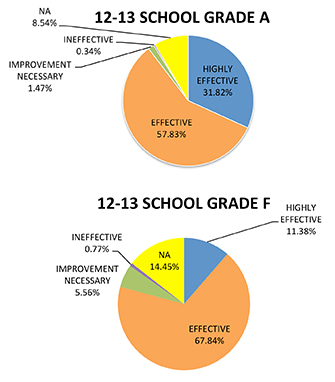Five Takeaways From The 2012-13 Educator Effectiveness Ratings

Elle Moxley / StateImpact Indiana
Ben Davis Ninth Grade Center Assistant Principal Steve Samuel observes a lesson in Wes Upton's social studies class.
The vast majority of Indiana educators received “effective” or “highly effective” ratings during the first year of state-mandated teacher evaluations.
Indiana schools reported evaluating more than 55,000 teachers, counselors and administrators during the 2012-13 academic year, according to figures released Monday by the Department of Education. Of those licensed educators who were rated, more than 97 percent received the top two scores.
(You can look up the results for your school or corporation in our sortable tables.)
Indiana lawmakers voted in 2011 to overhaul how teachers are evaluated and paid. But the legislature stopped short of mandating what evaluation system each school corporation should use.
“This is not designed to compare one school corporation to another,” says Sen. Dennis Kruse, R-Auburn. “This is designed for a principal to do a vigorous evaluation of their teachers in their building.”
Every district must divide teachers into four categories and include student test score data as a factor in assigning ratings. Still, the criteria used to determine a teacher’s rating could look very different as you travel district to district.Lawmakers did require districts to link their evaluation system to teacher pay. Some districts have overhauled their salary schedule as a result. Others will reward teachers who received top ratings with a one-time bonus.
Here are five things to know about Indiana’s first-ever educator effectiveness ratings.
- Sixty Indiana school corporations did not report any “ineffective” or “improvement necessary” educators. The vast majority of school corporations placed 90 percent or more of their teachers in the top categories. “One of my first impressions would be also, that’s a pretty high percentage to be the top two categories,” Kruse tells StateImpact. “But I have visited many schools … and I honestly am impressed with the teachers when I go into the schools and when I go into classrooms and I meet with teachers. We have a lot of good teachers in Indiana.”
- Your school or district may be missing from the 2012-13 data. Also in 2011, state lawmakers changed the rules for collective bargaining — and many districts rushed to sign extended contracts before the law took effect on July 1, 2011. That means those districts won’t be required to report their evaluation results to the state until after those contracts expire. You can find the full list of districts that did not submit results here.
-

Indiana Department of Education
Teachers at F-rated schools were more likely than teachers at A-rated to schools to go unranked during the 2012-13 school year.
Even if your school rated educators this year, your child’s teacher may not have been evaluated. Across the state, about 10 percent of educators in districts that submitted data did not receive a rating for the 2012-13 school year. That’s because the teachers didn’t satisfy all the requirements for evaluation. For example, the teacher might have retired mid-year or taken time off under the Family and Medical Leave Act. According to an IDOE analysis, teachers at schools that received an F from the state were somewhat more likely than educators at A-rated schools not to receive a rating.
- Two-thirds of school corporations are using the state’s teacher evaluation model or a modified version of it. The IDOE developed and piloted the RISE model under former state superintendent Tony Bennett. The state model calls for making student test score data a bigger part of a teacher’s rating in grades where standardized tests are given. But many districts have tweaked that model so test scores are given the same weight for all teachers. Districts are free to change which evaluation system they are using from year to year, says IDOE spokesman Daniel Altman. “We don’t support one model over another.”
- Charter schools aren’t required to report their data to the state — at least not yet. Legislation passed this session will also require public charter schools to report their teacher evaluation results to the state. Private schools, however, will remain exempt from Indiana’s educator effectiveness requirements.
